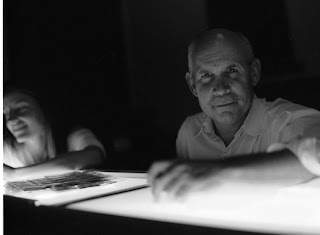People say a picture is worth a thousand words, this is proved right by the legendary Steve McCurry. Born in Philadelphia in the year 1950, he attended the College of Arts and Architecture at the Pennsylvania State University. Finding the “Essence of human struggle and joy” McCurry focuses on war and how it affects the landscape and us humans. After 2 years of working for a newspaper, McCurry flew off to India for self employment. McCurry’s career went skyrocket when he crossed the Pakistan border with film sewn into his clothing, these pictures were the first to show the position the Pakistani people were in, thus him wining various awards for bravery and endeavor.
He believes in hard work and how you grow by every experience you go through. “’If you wait’, he realized, ‘people will forget your camera and the soul will drift up into view." This quote proves to me his passion for photography, how he wants to see change in the world and showing this through his art would captivate people, making them wonder.
This vivacious photograph was taken in Rajasthan, India in 1996. In this picture I can see a pair of feet wearing a well crafted pair of jutis. I can see a dhoti (worn by Indian men) died in red, similar to the colors of the picture. His feet and the ground are covered in colored powder. Ripped and ruptured the jutis the man is wearing seem to be old. Holi which is a colorful Hindu festival is an occasion in which colored powder known as gulal is sprinkled; this photograph could be an evidence of the spring festival, known as the celebration of unity and brotherhood. What caught my eye was the spot of green smack in the middle of the picture, a contrast of colors and emotions. What interests me most, is the difference between the mood of the picture and what I think the meaning of the photo is, the colors are vibrant and remind me of spring, and the great variety of color. It reminds me of my experience when celebrating Holi, and the joy it brings with itself. The jutis, however, have major differences between the feelings of colors. Torn and scraped, the jutis reminds of sadness and pain, of poverty. “It is my hope that these images will provide a record of lost moments of culture.” The picture overlooks aspects of everyday life, compared to culture and celebration. It celebrates religion as well as human suffering and life. The simplicity and quality of this image shows how good a photographer McCurry is.
“Today we have many more soldiers, contractors, and NGO’S than we did five years ago, yet it is far more dangerous today than it was then. That tells me that many do not understand the country, the history, the people, the terrain, the language, the religion, the culture.” Steve McCurry has a way of illustrating his message instead of writing it below the image or making it too obvious. Doing so himself, he says being curious, hard working, being able to leave your comfort zone, having determination, the creativity to dig deep in, letting things change you and never letting an opportunity go are ways to become a successful photographer. McCurry’s photography turned him into a humanitarian, people are easily moved by his portraits, and how he conveys the message. The encouragement from National Geographic raised more awareness through publishing his work.
A great photo, what makes a great photo? It’s color? It’s background? According to Steve McCurry, that’s not all that gives a portrait its greatness, its meaning and what it’s trying to convey. A photo that’s makes you go “whoa” is an achievement for the photographer itself. Both paintings and photos make history, how and why? An image should have something special, it’s meaning so strong and deep it raises the hair on your arms. Reading an image is a challenge in itself. Observing each and every detail, reading between the lines, are key to reading a photograph. Each and every place Steve McCurry visits he brings back memories through his pictures, each picture drawing out its own story. His journey can be read, it can be observed, through his very own art, and passion for photography.
Steve McCurry expresses his emotions through his photography, each photo is unique in its own way, writing its own story out. The themes in his photos vary in style and color contrast, his pictures not only stand out but imprint its message in the viewers heads.
Picture 1: http://ivan-t3.deviantart.com/art/Steve-McCurry-55602160
Picture 2: http://www.stevemccurry.com/main.php
Picture 3: http://www.nz20.com/media/1/20090814-im11.jpg



1 comment:
Strong writing. I particularly liked, "Each and every place Steve McCurry visits he brings back memories through his pictures, each picture drawing out its own story. His journey can be read, it can be observed, through his very own art, and passion for photography" - yes. Nicely put. You identified the contrast between the joy of Holi and the man's suffering, the strength in the photo through leaving the message 'unsaid' yet 'said' and the capturing the moment. Steve McCurry does this very well. Your style was great - asking questions, then answering them with your ideas. Nice work.
Post a Comment